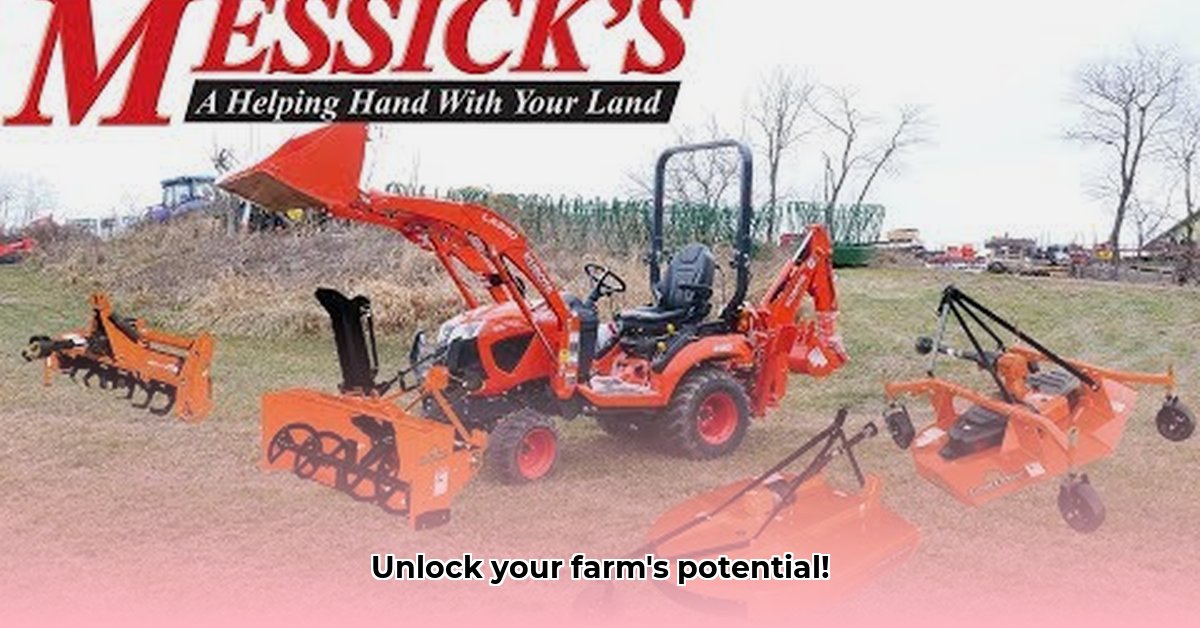
Small Tractor Attachments: A Game Changer for Sustainable Farming
Ready to supercharge your small farm's efficiency and sustainability? Small tractor attachments transform your compact tractor from a basic machine into a versatile powerhouse, handling numerous tasks from soil preparation to harvesting. This guide helps you choose the right attachments to boost yields while minimizing environmental impact, regardless of your farming experience. For more information on garden tractors and their attachments, check out this helpful resource: more info.
Picking the Perfect Attachments: A Step-by-Step Approach
Selecting the optimal attachments requires careful consideration of your specific needs. This decision hinges on several key factors:
Assess Your Farm's Size and Crops: A small backyard farm's needs differ significantly from a larger operation. The crops you grow dictate the essential attachments. Vineyards, for instance, require different tools than cornfields.
Determine Your Budget: Attachments vary greatly in price. Prioritize essential tools, gradually adding others as your budget allows.
Evaluate Your Land's Terrain: Steep hills or rocky terrain may necessitate specialized attachments designed for challenging conditions.
Answering these questions narrows down your options, making the selection process significantly easier. Let's explore common attachments and their applications.
Essential Small Tractor Attachments: A Detailed Overview
This table outlines popular attachments, their functions, advantages, disadvantages, and environmental benefits:
| Attachment | Function | Advantages | Disadvantages | Environmental Benefits |
|---|---|---|---|---|
| Plows | Turns over soil, exposing buried nutrients. | Excellent soil mixing, weed removal. | Can increase soil erosion, high fuel consumption. | Consider no-till methods for reduced erosion. |
| Tillers | Breaks up soil for aeration and improved drainage. | Lower fuel consumption than plows, reduces erosion. | May struggle in heavy clay soils. | Improves soil structure, lessens soil compaction. |
| Cultivators | Removes weeds and loosens soil. | Effective weed control, reduces herbicide use. | May require multiple passes for stubborn weeds. | Reduces herbicide dependence, promotes soil health. |
| Box Scrapers | Levels and smooths ground. | Versatile, affordable. | Potential soil compaction with overuse. | Improves water drainage, reduces runoff. |
| Post Hole Diggers | Digs holes for fencing or tree planting. | Accurate, efficient hole digging. | Difficulties in rocky or hard soil. | Reduces manual labor, simplifies planting. |
| Front-End Loaders (Buckets) | Lifts and moves materials (feed, manure). | Highly versatile, time-saving. | Requires cautious operation to prevent damage. | Reduces manual labor. |
| Mowers | Cuts grass for hay or pasture maintenance. | Efficient grass cutting, various grass types handled. | Requires regular sharpening and maintenance. | Reduces fire risk, maintains pasture health. |
| Sprayers | Applies fertilizer, pesticides, or herbicides. | Efficient application, minimizes waste. | Requires careful calibration and safety precautions. | Enables precise application, reducing chemical use. |
Did you know? Choosing the right mower can significantly impact fuel efficiency. Rotary mowers generally consume less fuel than flail mowers, making them a more sustainable choice for smaller areas. Source: [1]
Maximizing Attachment Lifespan and Sustainability
The longevity and environmental friendliness of your attachments extend beyond their initial function.
Prioritize Regular Maintenance: Clean and lubricate your attachments regularly to prevent premature wear and tear, extending their lifespan significantly.
Emphasize Safe Operation: Always follow the manufacturer's instructions to avoid accidents and equipment damage.
Integrate Sustainable Farming Techniques: Combine attachments with sustainable farming practices. For example, no-till farming with a tiller reduces erosion, while precise spraying minimizes chemical use. This approach reduces the overall environmental footprint of your operation.
Quantifiable Fact: Proper maintenance can extend the lifespan of your attachments by up to 25%, resulting in cost savings and reduced waste.
Choosing Wisely: Fuel Efficiency and Beyond
Investing in attachments is a significant decision. Beyond the immediate cost, consider these additional factors:
Compatibility: Assure seamless integration with your tractor's hydraulic system to avoid decreased performance and increased wear.
Durability and Maintenance: Prioritize high-quality attachments from reputable manufacturers for longevity and reduced long-term costs.
Weight: Heavier attachments increase fuel consumption; choose appropriately sized tools to maintain efficiency.
Consider Electric Options: Explore electric or battery-powered attachments to eliminate direct fuel consumption, enhancing sustainability further.
Strategic Implementation for Enhanced Fuel Efficiency
Optimizing attachment utilization is crucial for maximizing fuel efficiency and minimizing environmental impact.
Regular Tractor Maintenance: Keep your tractor in optimal condition to prevent fuel-wasting mechanical issues.
Efficient Work Planning: Group similar tasks together to minimize idling and restarts, conserving fuel. Careful planning can save up to 15% on fuel consumption.
Appropriate Tractor Sizing: Avoid underpowering your tractor, which increases fuel use.
Field Preparation: Properly maintaining your fields minimizes the effort required from your tractor and consequently reduces fuel consumption.
Expert Opinion: "Strategic attachment selection and proper maintenance are key to maximizing the efficiency and sustainability of your small farm operations," says Dr. Amelia Hernandez, Agricultural Engineering Professor at State University.
Call to Action: Begin optimizing your farm's efficiency today! Research different attachments, consult with local agricultural experts, and make informed choices to build a thriving and sustainable operation.